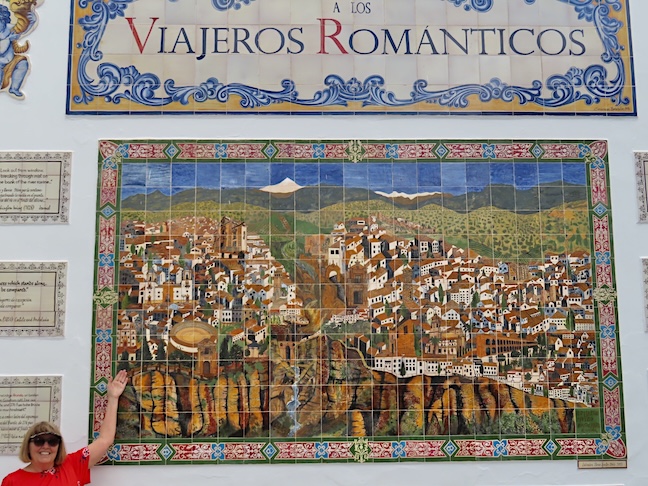
We bid despedida, or farewell, to Granada and boarded the bus for a 110-mile drive to Ronda in the Sierra de las Nieves National Park. The city of 35,000 is split on one corner by a spectacular gorge separating the old-town quarter from modernization.

Near Antequera Málaga, we take an upscale potty break at the Antequera Dolmens, a UNESCO World Heritage Site. The Dolmen of Menga was constructed around 3750-3650 BC. Dolmens are believed to be funerary or religious sites. This one was opened in the 19th century, revealing several hundred human skeletons.

Dolmen de Menga is 90 feet long, 20 feet wide, and 11 feet tall, making it much larger than Stonehenge. Thirty-two megaliths were dragged a half mile to this location, the largest being a capstone, which weighed 200 tons. To insulate the chamber and add stability the structure was covered with soil. The Dolmen’s entrance faces “The Indian of Antequera,” a mountain shaped like an Indian lying on his back.

We are leaving the land of endless olive groves that cling to the foothills.

The scenery is beautiful as the plains give way to jagged mountains.

The big bus can not negotiate the narrow streets of Ronda. We are dropped off near Ronda’s bullring, where we’ll enjoy a handheld audio-guided tour.

Plaza de Toros de Ronda is 217 feet in diameter and, with 5,000 seats, it’s considered rather small, but the actual bull ring where the action takes place is the largest in Spain. Built from 1779 to 1785, it was the first bullfighting ring in Spain, built entirely of stone with no brick.

A bronze statue of famous bullfighter Antonio Ordóñez, who slew over 3,000 bulls, adorns one of the bullring’s entries. Antonio was close friends with Ernest Hemingway and Orson Welles. Welles’ ashes were interred in a water well and covered in flowers on Antonio’s nearby property in 1987.

It’s a tight squeeze behind the wooden wall Barrera when dodging an angry bull. The organic yellow sand forming the arena’s surface is called Albero. Madonna shot her “Take A Bow” music video here in 1994.

The Museo Taurio under the bullring has two centuries of historic bullfighting treasures. Ronda is the home of Spain’s noblest order of horsemanship, Real Maestranza de Caballeria. Their weapons are also on display here.

Patrons and bullfighters wear their finest attire to the ring. Matadors’ outfits evolved into elaborate costumes. Professional bullfighters’ capes weigh from 9 to 13 pounds and are red to hide the bull’s blood. It’s the movement, not the color of the cape, that enrages the bull.

Two blocks from the bullring is the Tajo Gorge separating Old Ronda from the New.

The dramatic gorge was created 5,000 years ago by seismic movement.

Puente Nuevo, or New Bridge, was first built in 1735 to link the New and Old sections of Ronda. It crumbled, killing 50 people several years later. Construction on the current bridge began in 1759, was completed in 1793, and stands 300 feet high.

Hair nets under hard hats are required to take the gorge walkway to the base of the New Bridge. It’s worth the 5 euros to protect your noggin from falling rocks and tourist debris from above.

We were famished after our steep descent and climb in Tajo Gorge. Our guide, Agustin, pointed out his favorite tapas bar on our walk into town from the bus, and it was packed to overflowing into the street with locals when we arrived. We shoehorned into a small opening at the bar and enjoyed the boisterous show until the crowd retreated for siesta or work.

At the peak of the frenzied eating and drinking, armloads of tapas and drinks were whisked through a window from a tiny kitchen behind the compact bar. Patrons were three deep at the bar and tiny indoor tables. Piles of empty drink containers and dirty dishes filled plastic trash cans that dishwashers drug back to the kitchen through a side door.

Salted and cured hams hung in every eatery we visited in Spain. During the curing process, the legs sweat off half their weight. We were exhausted after the frantic exertion in this awesome dive bar, turning lunch into an event.

From Ronda, we squeezed down narrow rural roads dwarfed by our lux bus to the Hotel Boutique Molino del Arco, an 18th-century Andalusian farmhouse in the Sierra de Salinas foothills.

We arrived at the end of the hotel’s busy season and had the place to ourselves. The country setting was perfect for relaxing.

I took a walk before dinner through the surrounding vineyards with olive orchards nearby. The Clavero Family, owners of the Molino, are recovering the tradition of producing extra virgin olive oil.

Our group dinner was locally sourced and left everyone plump and happy after a fun day on the road and exploring Ronda.

